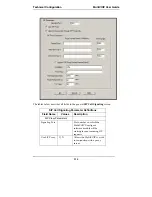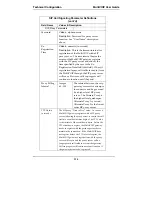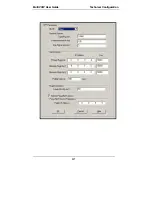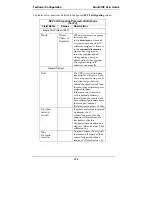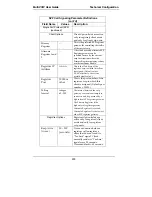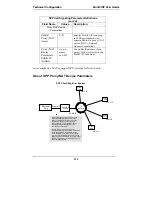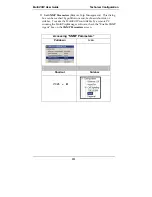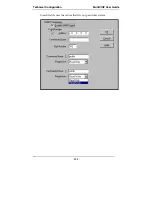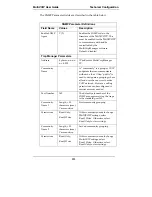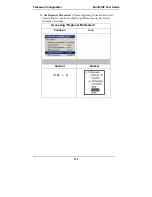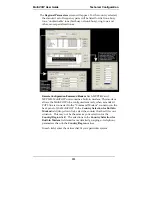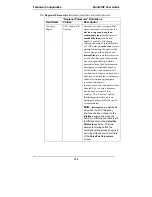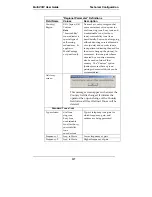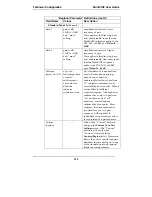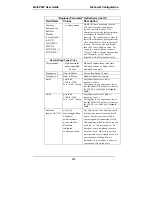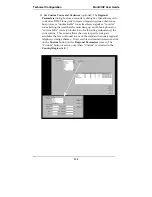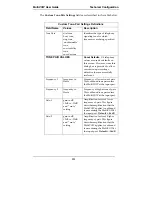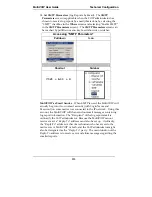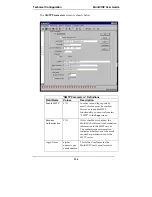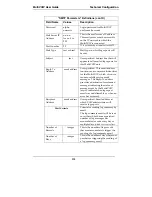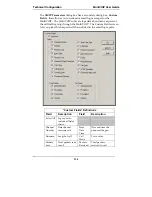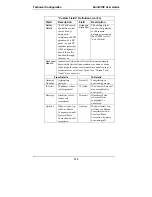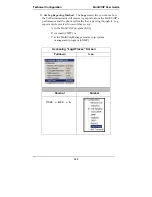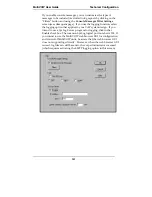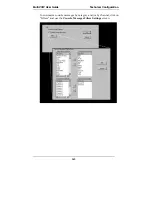
Technical Configuration
MultiVOIP
User
Guide
128
“Regional Parameter” Definitions (cont’d)
Field Name
Values
Description
Standard Tones
fields
(cont’d)
Gain 1
gain in dB
+3dB to –31dB
and “mute”
setting
Amplification factor of lower
frequency of pair.
This applies to the dial, ring, busy
and ‘unobtainable’ tones that the
MultiVOIP outputs as audio to the
FXS, FXS, or E&M port.
Default:
-
16dB
Gain 2
gain in dB
+3dB to –31dB
and “mute”
setting
Amplification factor of higher
frequency of pair.
This applies to the dial, ring, busy,
and ‘unobtainable’ (fast busy) tones
that the MultiVOIP outputs as
audio to the FXS, FXO, or E&M
port.
Default: -16dB
Cadence
(msec) On/Off
n/n/n/n
four integer time
values in
milli-seconds;
zero value for
dial-tone
indicates
continuous tone
On/off pattern of tone durations
used to denote phone ringing,
phone busy, connection
unobtainable (fast busy), dial tone
(“0” indicates continuous tone),
survivability, and re-order. Default
values differ for different
countries/regions. Although most
cadences have only two parts (an
“on” duration and an “off”
duration), some telephony
cadences have four parts. Most
cadences, then, are expressed as
two iterations of a two-part
sequence. Although this is
redundant, it is necessary to allow
for expression of 4-part cadences.
Custom
(button)
--
Click on the “Custom” button to
bring up the
Custom Tone Pair
Settings
screen. (The “Custom”
button is active only when
“Custom” is selected in the
Country/Region
field.) This screen
allows the user to specify tone pair
attributes that are not found in any
of the standard national/regional
telephony toning schemes.
Summary of Contents for MULTIVOIP MVP-3010
Page 6: ...6 Chapter 1 Overview ...
Page 28: ...28 Chapter 2 Quick Start Instructions ...
Page 38: ...Technical Configuration T1 E1 MultiVOIP User Guide 38 Chapter 4 Software Installation ...
Page 49: ...49 Chapter 5 Technical Configuration ...
Page 58: ...Technical Configuration MultiVOIP User Guide 58 Config Info CheckList ...
Page 117: ...MultiVOIP User Guide Technical Configuration 117 ...
Page 139: ...MultiVOIP User Guide Technical Configuration 139 ...
Page 170: ...170 Chapter 6 T1 Phonebook Configuration North American Telephony Standards ...
Page 184: ...T1 Phonebook Configuration MultiVOIP User Guide 184 3 Select Inbound PhoneBook List Entries ...
Page 208: ...208 Chapter 7 E1 Phonebook Configuration European Telephony Standards ...
Page 252: ...252 Chapter 8 Operation and Maintenance ...
Page 257: ...MultiVOIP User Guide Operation Maintenance 257 The Call Progress Details Screen ...
Page 265: ...MultiVOIP User Guide Operation Maintenance 265 The Logs Screen ...
Page 277: ...MultiVOIP User Guide Operation Maintenance 277 ...
Page 280: ...Operation and Maintenance MultiVOIP User Guide 280 T1 Statistics Screen ...
Page 288: ...Operation and Maintenance MultiVOIP User Guide 288 ...
Page 343: ...343 Chapter 9 Warranty Service and Tech Support ...
Page 347: ...347 Chapter 10 Regulatory Information ...
Page 352: ...352 Appendix A Cable Pinouts ...
Page 358: ...358 Appendix B TCP UDP Port Assignments ...
Page 360: ...360 Appendix C Installation Instructions for MVP428 Upgrade Card ...
Page 365: ...MultiVOIP User Guide Index 365 Index ...
Page 395: ...395 S000384A ...

